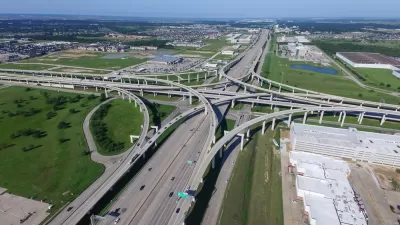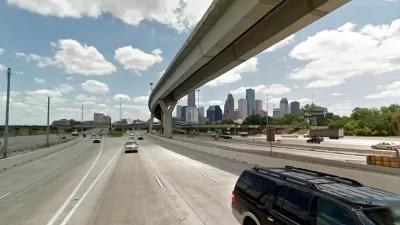CityLab University tackles a widely misunderstood concept: induced demand.

CityLab University endeavors to provide clear explanations of some of the "most important concepts related to cities and urban policy." A previous post explained inclusionary zoning, for instance. For the most recent post, Benjamin Schneider explains the concept of induced demand, or why new road capacity doesn't reduce traffic.
Launching the explanation with the example of the Katy Freeway in Houston, which has 26 lanes at its widest point, and still sees worsening congestion.
The idea that the Katy Freeway could expand to such capacity and still see regular congestion is explained by induced demand. While Schneider goes into a lot more detail in the source article, here are the key points that organize the article:
- In urbanism, “induced demand” refers to the idea that increasing roadway capacity encourages more people to drive, thus failing to improve congestion.
- Since the concept was introduced in the 1960s, numerous academic studies have demonstrated the existence of ID.
- But some economists argue that the effects of ID are overstated, or outweighed by the benefits of greater automobility.
- Few federal, state, and local departments of transportation are thought to adequately account for ID in their long-term planning.
FULL STORY: CityLab University: Induced Demand

Alabama: Trump Terminates Settlements for Black Communities Harmed By Raw Sewage
Trump deemed the landmark civil rights agreement “illegal DEI and environmental justice policy.”

Planetizen Federal Action Tracker
A weekly monitor of how Trump’s orders and actions are impacting planners and planning in America.

The 120 Year Old Tiny Home Villages That Sheltered San Francisco’s Earthquake Refugees
More than a century ago, San Francisco mobilized to house thousands of residents displaced by the 1906 earthquake. Could their strategy offer a model for the present?

In Both Crashes and Crime, Public Transportation is Far Safer than Driving
Contrary to popular assumptions, public transportation has far lower crash and crime rates than automobile travel. For safer communities, improve and encourage transit travel.

Report: Zoning Reforms Should Complement Nashville’s Ambitious Transit Plan
Without reform, restrictive zoning codes will limit the impact of the city’s planned transit expansion and could exclude some of the residents who depend on transit the most.

Judge Orders Release of Frozen IRA, IIJA Funding
The decision is a victory for environmental groups who charged that freezing funds for critical infrastructure and disaster response programs caused “real and irreparable harm” to communities.
Urban Design for Planners 1: Software Tools
This six-course series explores essential urban design concepts using open source software and equips planners with the tools they need to participate fully in the urban design process.
Planning for Universal Design
Learn the tools for implementing Universal Design in planning regulations.
Clanton & Associates, Inc.
Jessamine County Fiscal Court
Institute for Housing and Urban Development Studies (IHS)
City of Grandview
Harvard GSD Executive Education
Toledo-Lucas County Plan Commissions
Salt Lake City
NYU Wagner Graduate School of Public Service





























